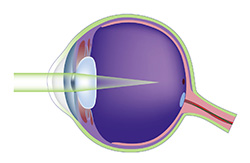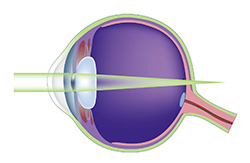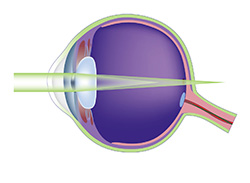Understanding Common Vision Problems
4 common problems that can be corrected by LASIK corrective eye surgery
There are three main parts to the human eye: the cornea, the lens, and the retina. The retina is like the film in a camera. In normal vision, the cornea refracts (bends) light so it can be directed correctly through the lens and onto the retina. Vision problems requiring glasses or contact lenses are usually the result of disorders or irregularities of the shape of the cornea. These vision problems include:
Another common vision problem for people over the age of 40 is presbyopia. This is caused by a hardening of the lens of the eye that comes with aging.
Dr. Manger solves all of these problems by using All-Laser Custom LASIK to reshape the curvature of the cornea so that normal, clear sight is obtained. Learn more about the LASIK procedure, step-by-step.
Contact Us

Nearsightedness (myopia)
Nearsighted people can see close objects clearly but objects in the distance are blurry. Nearsightedness occurs when the cornea is too steep or the eye is too long. This causes light to focus in front of the retina, resulting in blurry distance vision. LASIK corrective eye surgery addresses this condition by flattening the curvature of the cornea.

Farsightedness (hyperopia)
Farsighted people see distant objects better, but intermediate and close-up objects are blurred. Farsightedness occurs when the cornea is too flat, or the eye is too short, causing light rays to focus behind the retina. LASIK corrective eye surgery fixes this condition by steepening the cornea so that it focuses images onto the retina.

Astigmatism
Astigmatism is the inability to focus clearly at any distance due to an irregular or misshapen cornea. With astigmatism, the cornea is shaped more like a football than a basketball, and light rays focus at different points on the retina. This causes both distant and near images to be distorted. People who are nearsighted or farsighted can also have astigmatism, or astigmatism can occur by itself. LASIK eye surgery for astigmatism corrects the oval shape so images can be clearly focused on the retina.

Presbyopia (reading glasses)
Patients over the age of 40 often find that they can no longer see up-close without the need for reading glasses. This condition is known as presbyopia and is caused by the hardening and thickening of the lens that comes with aging. Presbyopia is not the same as farsightedness; farsightedness is caused by a cornea that is too flat or an eye that is too short. With presbyopia, the muscles of the eye can no longer change the shape of the hardening lens to focus on near objects, causing them to be blurry or out of focus.
If you have presbyopia, you may have been told there is not a good answer for reading glasses or you may not have liked the “standard monovision” that you previously tried. Dr. Manger is an expert with “blended monovision,” which allows patients to see both distance and near. This can eliminate the need for reading glasses for most, if not all, up-close activities.
*Offer limited to 10 free LASIK exams per day. Regular fee schedule available at time of consultation. $200 exam fee will apply to patients who have had any previous eye surgery. This fee will be applied towards surgical procedure.
On occasion, the Intralase procedure cannot be performed on a patient due to various eye conditions such as corneal scarring, small orbits or previous refractive surgeries. In these cases, PRK may be considered as an alternative to LASIK.
Cannot be combined with other offers or insurance. LASIK $2,150-$3,550 per eye. $800 discount when LASIK is performed on both eyes. Single-eye LASIK procedures receive a $400 discount.
Receive an additional $250 discount per eye when you have your LASIK exam and LASIK procedure done on the same day. Regular fee schedule available at time of examination. Cannot be redeemed for cash. Certificate has no cash value.
LASIK is a surgical procedure intended to reduce and potentially eliminate your need for glasses or contact lenses. As with all surgical procedures, there are risks that will be discussed with you prior to having your procedure. These risks include, but are not limited to fluctuating vision, visual symptoms like glare or haloes around lights, dry eyes that require eye drops, and the occasional need for a retreatment.
No


